Optimizing School Management through Genetic Algorithm-Driven Pattern Mining for Educational Process Enhancement
Authors :
Kavitha and Ashok Kumar
Address :
Dept of Computer Science and Engineering, Vinayaga Missions Kirupanda variyar Engineering College, Vinayaga Missions Research Foundation (Deemed to be University), Salem
Dept of Computer Science and Engineering , Skyline University, Nigeria
Abstract :
Improving school administration procedures is a crucial goal in the constantly changing field of education. Genetic algorithms (GA), influenced by natural selection, repeatedly examine possible solutions, assess their suitability, and progress towards the best patterns. In educational settings, this repeated improvement process enables the identification of concealed patterns in various datasets, such as student performance statistics, resource distribution trends, and administrative procedures. By using genetic algorithms, policymakers and educators have access to an advanced set of tools for making decisions based on data and improving processes. This paper introduces an Educational Optimization Genetic Algorithm (EOGA), a new approach for pattern mining to enhance school management operations. The suggested method deals with the changing nature of educational leadership by providing flexibility to adapt to different situations and developing priorities. Genetic algorithms help continuously improve and optimize school administration procedures, allowing institutions to adjust to new challenges and possibilities. By using genetic algorithm-based pattern mining, educators and others can discover detailed insights that standard analytical methods could miss. These understandings help administrators make educated decisions about resource distribution, curriculum improvement, and student assistance, leading to better educational results and organizational efficiency. By adopting a data-focused method, schools can go beyond conventional thinking and make ongoing enhancements in several aspects of school administration. Incorporating genetic algorithms into educational practices significantly promotes creativity, effectiveness, and high quality in education.
Keywords :
Educational Optimization Genetic Algorithm; Pattern mining; School management; Educational optimization; Decision-making; Student performance.
1.Introduction
Both academic and corporate communities, both domestically and internationally, consider the study and creation of data mining software and technological tools to be highly significant. Data mining is a relatively new and dynamic area of research that integrates recent findings from various fields such as database technology, machine learning, artificial intelligence, statistics, knowledge technology, object-oriented methods, information retrieval, computing with high performance, and data visualization [1]. Creating a versatile and robust algorithm or methodology for examining and combining different geospatial datasets is crucial for creating a practical mineral prospectivity map to identify locations with a high likelihood of containing valuable minerals [2]. Data mining is a modern technology that has been created in recent years. Through data mining, individuals can uncover the valuable and possible insights concealed inside the data, offering robust assistance in making a wide range of business decisions based on scientific evidence [3]. Professor John Holland, a professor at the educational institution of Michigan, proposed and developed the genetic algorithm (GA) from 1950 to 1960. Due to its flexibility and durability, GA can outperform other algorithms in addressing incredibly intricate spatial problems [4]. In the case of the GA, a pair of genetic processes, crossover and mutation, directly impact the overall efficiency of the genetic algorithm [5]. Varying fields have distinct methods for examining similar issues, leading to diverse needs for data processing methods. A student information system is a whole management system that includes modules for managing students, teaching, enrollment, and overall quality assessment [6].
These configurations have generated a significant amount of data, resulting in the requirement for data mining in education (EDM) and learning data analysis (DA) to collect and analyze the data. The goal is to improve learning and teaching by enhancing students' performance and skills or supporting teachers [7]. Conventional methods for mining association rules at multiple levels produce numerous potential items and then assess them against the entire database [8]. Education data mining entails utilizing data mining technologies to examine many student-related data kept in the institution's educational administration systems. The goal is to extract valuable information and knowledge that can enhance students' learning outcomes and improve the school's quality of education and teaching [9]. The creation and management of teaching materials can be utilized to assess a school's overall effectiveness and level of educational management. Colleges and universities primarily focus on managing and developing educational materials, reflecting these institutions' teaching, research, and administrative aspects [10]. The study collects current and natural interactions and conversations on ChatGPT through web mining from educational forums and platforms [11]. In addition, machine learning helps simplify complex and extensive data by identifying patterns and trends. The method goes beyond the traditional survey and opinion-based studies, placing this work at the forefront of empirical research on AI's educational impacts [12]. The primary goals of this paper are,
- To introduce an Educational Optimization Genetic Algorithm (EOGA), a new approach for pattern mining to enhance school management operations.
- To deal with the changing nature of educational leadership by providing flexibility to adapt to different situations and developing priorities.
- By using genetic algorithm-based pattern mining, educators and others can discover detailed insights that standard analytical methods could miss.
- To help administrators make educated decisions about resource distribution, curriculum improvement, and student assistance, leading to better educational results and organizational efficiency.
- By adopting a data-focused method, schools can go beyond conventional thinking and make ongoing enhancements in several aspects of school administration.
The rest of the paper has been divided into four main sections: Section 1 covers related works that describe the existing work of student’s performances in school management, Section 2 is given with proposed work that describes the overall work and flow chart model of the proposed EOGA, Section 3 covers with results and discussion, and finally, Section 4 concluded the work along with future studies.
2. Related works
Uda, S., and B. Basrowi [13] proposed how SARITHA-Apps improve sustainable business practices in firms' supply networks. The study seeks to evaluate how successful SARITHA-Apps are in improving individual environmental knowledge. It also aims to study the factors that impact the use and approval of SARITHA-Apps in business settings. Moreover, the study aims to provide suggestions for businesses and creators of comparable apps to improve the use of educational technology for environmental education, thereby fostering awareness of sustainability in organizational environments.
Kilag et al. [14] proposed the significant impact of strong leadership on student success, as shown by a meta-analysis indicating a noteworthy effect size. This study aims to explore the changing environment of educational direction, with a specific emphasis on a new method called 'school leader research.' This research investigates how participating in the research process might help school leaders strengthen their leadership skills and create evidence-based strategies for long-term school reform by combining practitioner research with their daily duties.
Yumhi et al. [15] proposed the process of documenting employee knowledge, which can be systematically and centrally recorded using the knowledge management system (KMS). This technology will allow staff to manage, store, and share knowledge efficiently. Introducing this approach is anticipated to enhance employee efficiency and effectiveness while maximizing the utilization of company-owned knowledge.
Venkateswaran et al. [16] investigated the significant effects of ICT (information and communication technology) on higher education. The study will explore how ICT has transformed instructional methods, student involvement, and administrative procedures in the last twenty years. The research will concentrate on the move towards student-centred learning aided by ICT and the improved effectiveness in administrative duties, including enrolment and communication. The study aims to create a favourable learning atmosphere by improving how lessons are designed and the assistance provided to students by incorporating ICT.
Kilag et al. [17] examined how the Learning Science Framework (LSF) is incorporated into educational leadership, emphasizing its beneficial effects on decision-making, teaching methods, and educational results. Leaders influenced by the LSF show improved decision-making skills and take into account mental processes and socio-cultural circumstances. Although there are advantages, difficulties in professional growth and continued use remain, necessitating continuous assistance. The LSF's flexibility in many educational settings highlights its potential to bring about change in building adaptable learning environments and inform evidence-based educational practices.
Guna et al. [18] proposed the intricate aspects of enhancing morals and ethics using Islamic religious instruction in schools. It combines current information, recognizes patterns, and offers perspectives for educators, politicians, and academics. The importance comes from the necessity to evaluate the level of ethics in Islamic religious teaching, dealing with issues like task automation and enhancing the human role. The review helps to understand and deal with moral problems in present situations by looking at several topics such as Islamic education, ethical and moral principles in Islam, and factors influencing them.
Cordova Jr et al. [19] proposed the complex connection between leadership methods in preschool classrooms and their long-term influence on children's reading and writing abilities. A holistic literature review emphasizes the strong connection between leadership that transforms and the early development of literacy. Leadership qualities like inspiring motivation and personalized attention are critical factors in promoting literacy. The study highlights the need for customized leadership strategies and stresses the crucial significance of language-rich settings and training in enhancing early childhood literacy programs.
3. Proposed work
a. Data collection
The set includes 480 student records and 16 attributes [20]. The characteristics are divided into three primary groups: (1) Traits such as sex and country of origin. (2) Academic background features including level of schooling, level of education, and section. (3) Behavioral traits consist of actions like raising hands in class, using materials, participating in parent surveys, and feeling satisfied with the school. The dataset contains 305 males and 175 females. The students come from different places, such as Kuwait (179 pupils), Jordan (172 pupils), Palestine (28 pupils), Iraq (22 pupils), Lebanon (17 students), Tunisia (12 students), Saudi Arabia ( eleven students), Egypt nine students), Syria (7 pupils), USA, Iran, and Libya (6 pupils each), Morocco (4 pupils), and Venezuela (1 student).
. The information is collected throughout the course of two academic years: 245 student records are collected in the initial semester, as well as 235 student records are collected in the following semester. The dataset also includes details on school attendance, with students categorized into two categories according on their total number of leave days: 191 children have over 7 absence days, whereas 289 students have under 7 absence days. This dataset also includes a new group of characteristics, one of that pertains to parental participation in education. The parent involvement feature consists of two sub-features: Parent Answering Survey as well as Parent School Satisfaction. Figure 1 shows the general operation of the suggested EOGA framework.
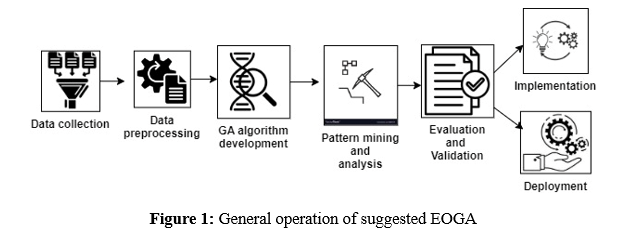
b. Algorithm development
Figure 2 illustrates the fundamental steps of the genetic algorithm. The primary stages can be outlined as follows:
Coding: Prior to searching, a genetic algorithm first encodes the solution data into the genetic time as information structured in a genotype string. Varying mixtures of these cord structure information make up distinct points.
Population initialization: Generate N unique whole integers randomly from the range [1,k], and combine these numbers to create individuals, where k represents the sample sizes and c represents the number of groups. If the population size is K, then K people are produced using the following procedure. The text is encoded using symbols, meaning that the specific code consists of the digits representing each of the N group hubs in the sample set. the portrayal of people is
Q={q_1,q_2,….q_n } (1)
Among them, N represents the number of groupings, q_i=1,2,…n indicating the quantity of the sample that corresponds to the i^th group centre within the sample set. This is an integer that ranges from one and k, in which k is the overall number of samples.
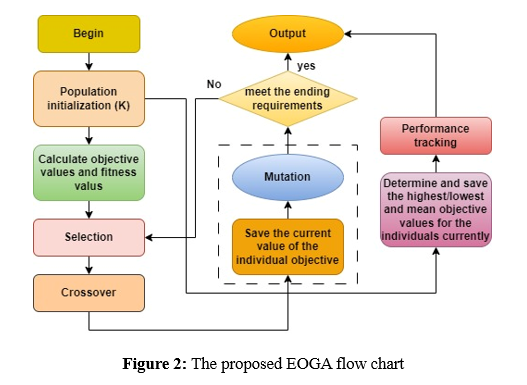
Fitness function evaluation test: The fitness assessment is important in genetic algorithms since it helps measure the effectiveness of solutions and directs the evolution process towards the best possible outcomes. Within the EOGA structure of educational leadership, fitness evaluation helps identify trends and techniques that can strengthen school administration operations, resulting in better educational outcomes and efficiency.
Selection: Criteria for selection in genetic algorithms decide which members from a group are picked for survival and reproduction in future generations. Tournament selection entails randomly choosing a group of individuals and selecting the most fit among them for reproduction. Roulette wheel selection gives each individual a chance of being selected based on their fitness compared to the whole population, where those with higher fitness are more likely to be chosen. Rank-based selection orders individuals according to their fitness and chooses them based on their rank's proportionate possibilities. These techniques guarantee that individuals with greater fitness contribute more to the next era, which helps advance evolution.
Crossover: Crossover is a crucial genetic function in genetic algorithms. A fresh group of people can be acquired through exchange activities. The new individuals inherit traits from their parents, and trade involves information sharing.
Variation: Variation starts by randomly selecting a person from the entire group before randomly adjusting the value of the string in the information framework with a certain chance for that person. Just like in nature, the chance of mutation in the genetic algorithm is often quite small, usually falling between 0.001 and 0.01. Mutation provides opportunities for the creation of new individuals.
c. Pattern mining and analysis
Exploring patterns and analyzing data under the EOGA framework requires a systematic approach to uncover possible solutions and detect concealed patterns in educational information.
Investigation of Possible Solutions: The EOGA framework uses genetic algorithms (GAs) to investigate an ample search space of possible solutions to optimization issues in school management. Genetic algorithms employ an evolutionary method influenced by natural selection to enhance solutions throughout numerous generations gradually. Each answer, shown as a chromosome or individual, has a group of factors that control several parts of school administration procedures, like resource distribution, curriculum creation, and administrative procedures.
Genetic Operators: The leading genetic operators used in the EOGA framework are:
- Selection: People from the existing population are chosen for reproduction according to their fitness scores. Healthier people are more likely to be chosen.
- Crossover: Chosen individuals experience crossover, where genetic material (parameters) is swapped between pairs of individuals to create children with mixed traits.
- Mutation: Occasionally, chosen individuals experience mutation, where random alterations are made to their parameters. Mutation brings variety to the population and stops early narrowing down to less effective options.
Assessment of Solutions: After using genetic operators, the fitness of each solution is assessed using a fitness function. The fitness function evaluates how well a solution meets the goals and limitations of optimizing school management. Alternatives with higher fitness ratings are seen as more advantageous and more probable to be selected for survival and reproduction in future generations.
Gradual Improvement: The process of exploring, assessing, and improving is repeated throughout several generations. With each cycle, the population changes, and solutions get more and more optimized. By repeatedly using genetic operators and evaluating fitness, the EOGA framework moves towards solutions that efficiently improve school administration operations.
Recognizing Patterns: As the EOGA framework goes through generations, it recognizes trends in the educational data that help improve school administration operations. These patterns can appear as data variables' trends, connections, or associations. By examining these trends, educational institutions can learn about successful methods for distributing resources, designing curricula, and managing administrative processes, which can result in better educational results and organizational effectiveness. In short, pattern discovery and analysis in the EOGA framework use genetic algorithms to search for and improve solutions that enhance school administration procedures methodically. By repeatedly using genetic operators and evaluating fitness, the system discovers concealed patterns in educational datasets and supports making data-informed decisions to strengthen education.
d. Evaluation and Validation
Assessment and confirmation processes are crucial for determining the effectiveness and dependability of the EOGA structure. At first, the quality and significance of found patterns are evaluated to make sure they match the goals of optimizing school management. Comparing EOGA-derived patterns with benchmark solutions and older methodologies helps us understand the extra benefits they bring. Sensitivity analysis methodically changes input parameters to assess how well the framework can handle different situations, helping to choose the best settings for the most effective results.
Cross-validation methods assess the framework's ability to apply to various datasets and educational environments, reducing the chances of overfitting. Several performance measures, including as precision, precision, accuracy, and computational effectiveness, are used to evaluate the framework's achievement and allow for comparisons with other optimization methods. Moreover, testing the EOGA framework with real-life situations and examples from educational settings confirms its practicality and ability to be scaled up, guaranteeing its effectiveness in tackling difficult problems and improving school management procedures to achieve better educational results.
e. Implementation and deployment
Following validation, the introduction and application of the EOGA framework at educational institutions represent an important stage. Functioning as a decision assistance group, EOGA provides useful insights and suggestions to politicians and educators, helping with informed choices and process improvement. The method of deployment includes smoothly incorporating EOGA into current educational management systems, making sure it is compatible and easy to use. Important parties are trained and supported to effectively use the framework's features and understand the insights it produces.
EOGA works by examining various kinds of data related to school management, including student performance measures, resource distribution records, and administrative protocols. Using data-driven analysis, EOGA finds patterns, trends, and connections in the data, providing practical suggestions to improve educational results and organizational efficiency. By using EOGA's abilities, educational institutions have an advantage in adjusting to changing difficulties and using data-driven methods for effective decision-making and ongoing development in educational operations.
4. Results and discussion
a. Improvement in school administrative efficiency
Decreased Administrative Time: This can be assessed by comparing the time needed to finish administrative duties before and after EOGA is put into place. The formula for determining the percentage decrease in time spent on administration is given as equation (2),
Percentage reduction=(Time before EOGA-Time after EOGA)/(Time before EOGA)×100 (2)
Enhanced Resource Usage: Resource utilization involves efficiently assigning and using resources, including staff, finances, and infrastructure. It may be measured by comparing the usage rates before and following EOGA deployment. The formula for resource usage rate is given in equation (3) as:
Resource utilization rate=(Actual resource usage)/(maximum resorce capacity)×100 (3)
Figures 3 (a) and 3 (b) visually show how school administration efficiency has improved by using EOGA. Educational institutions can evaluate how well the algorithm improves administrative processes and boosts operational efficiency by analyzing data before and after EOGA is implemented. Educational institutions can evaluate the concrete enhancements in administration efficiency achieved via EOGA by examining these measurements and assessing the outcomes. These measurements offer useful information on how well EOGA is improving administrative procedures and increasing overall operational effectiveness.
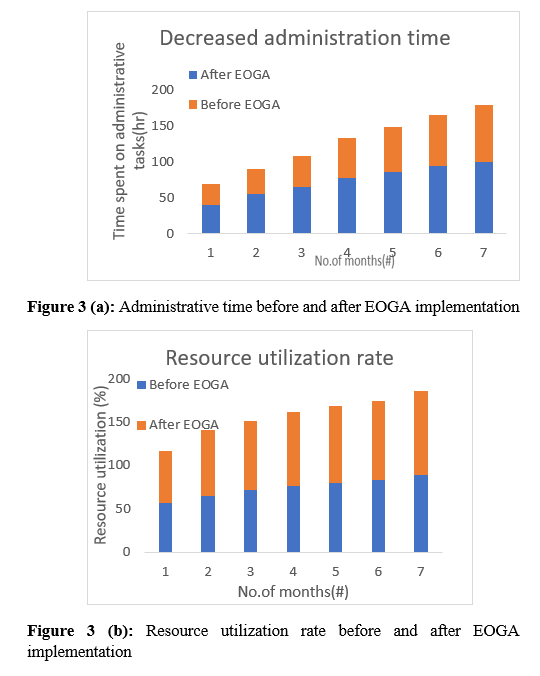
b. Educational outcomes enhancement
Assessing the effects of improved school management processes supported by EOGA in educational results includes analyzing different measurements connected to student success, rate of graduation, and overall academic performance.
Student Performance Data: Student performance metrics may include test scores, grades, and academic advancement. To assess progress in pupil achievement, you can determine the mean or median ratings before and after introducing EOGA and then compare them. The formula for determining the percentage increase in student achievement is given in equation (4) below,
Performance inprovement=(Average score after EOGA-Average score before EOGA)/(Average score before EOGA)×100 (4)
Graduation Rates: Graduation rates show the proportion of students who finish school within a set period. To evaluate the effect of EOGA on the graduation rate, compare the percentages of graduates before and after it was put into place. The formula for determining the percentage difference in the rate of graduation is shown in equation (5),
Percentage change=(Graduation rate after EOGA-Graduation rate before EOGA)/(Graduation rate before EOGA)×100 (5)
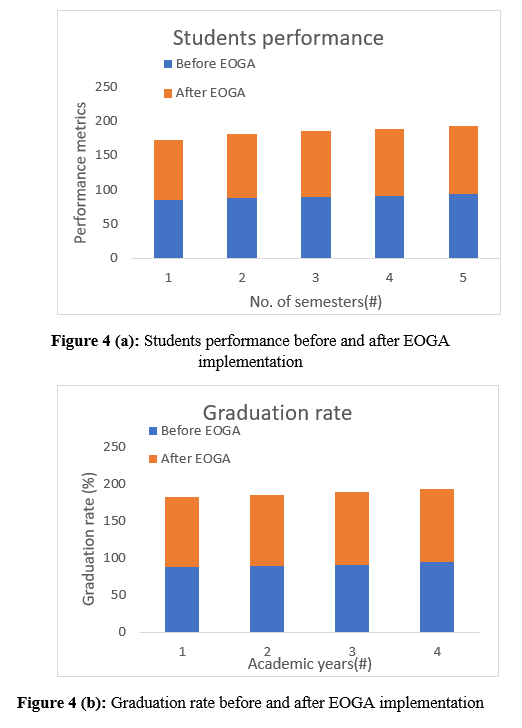
Educational institutions can evaluate the effects of enhanced school administration processes with EOGA support on student achievement and graduation rates by analyzing points of data before and after EOGA deployment as shown in figures 4 (a) and 4 (b) respectively. Educational institutions can assess the effects of improved school administration procedures using EOGA by examining these measurements and their related formulas on educational results. These evaluations offer important information about how EOGA impacts student performance, rates of graduation, and overall academic success.
c. Data-driven decision-making:
Evaluating how EOGA supports data-informed decision-making includes examining how data is used and its influence on resource distribution, curricular improvements, and student assistance programs.
Resource Distribution: Resource allocation is efficiently deploying financial, human, and physical assets to support learning programs and projects. The efficiency of using data to decide how resources are distributed can be assessed by comparing the actual use of resources with what was expected or considered the best allocation. The formula for evaluating resource allocation effectiveness is given in equation (6) as,
Resource allocation efficiency=(Actual resource utilization)/(Predicted or optimal resource allocation) ×100 (6)
Programs to Improve the Curriculum: Efforts to upgrade curriculum focus on improving the quality, significance, and efficacy of educational programs. Using data to make decisions about improving the curriculum includes examining student performance data, comments from those involved, and metrics for evaluating the curriculum. The formula for assessing the effects of curricular improvement projects is given in equation (7) as,
Curriculum enhancement impact=(Improvement in student performance)/(Baseline performance)×100 (7)
Figures 5 (a) and 5 (b) shows that the educational institutions can assess how EOGA supports data-driven decision-making in different educational areas by examining these equations and indicators. These evaluations include information about how well data is used to guide decisions on distributing resources, improving the curriculum, and supporting students, resulting in more successful and influential educational methods. Educational institutions can evaluate the influence of EOGA on data-driven choices in resource allocation and curriculum improvement by analyzing information points before and after EOGA adoption.
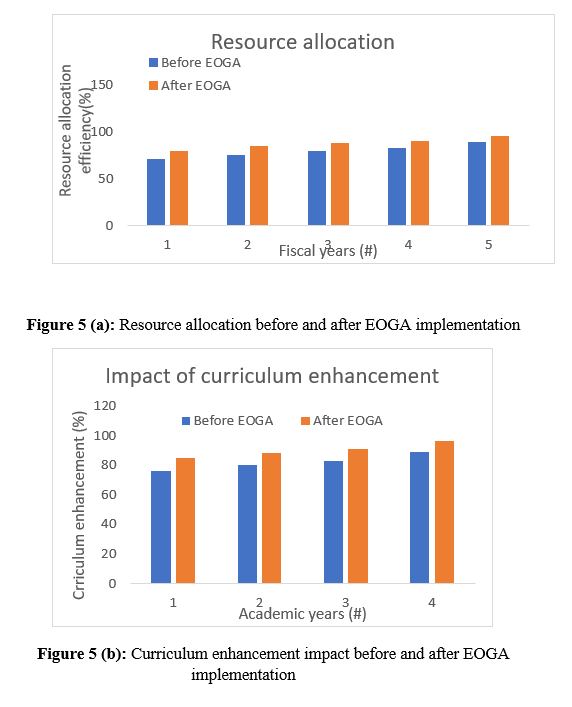
5. Conclusion
Overall, using genetic algorithms (GA) in educational management is a forward-thinking move to improve school administration processes in the ever-changing field of education. Guided by natural selection, genetic algorithms provide a methodical way to improve and enhance administrative procedures constantly. By systematically exploring different solutions, GA helps reveal hidden trends in educational data, enabling educators and policymakers to make well-informed decisions based on facts. Implementing the Educational Optimization Genetic Algorithm (EOGA) highlights a dedication to adjusting to the changing needs of educational leadership. EOGA offers a versatile structure that can handle various issues and priorities in educational institutions. Using neural networks for pattern mining, teachers can obtain detailed insights that standard analytical methods might miss. These observations are useful for improving how resources are distributed, developing curricula, and offering specific help to pupils. Moreover, using genetic algorithms to adopt a data-focused approach encourages a culture of innovation and ongoing enhancement in school administration. Educational institutions can move beyond traditional methods and adopt data-driven decision-making strategies by using GA-based pattern mining. Incorporating genetic algorithms into learning procedures has the potential to promote innovation, efficiency, and high quality in education. Basically, using genetic algorithms at educational management signifies a revolution in the way school administration is approached, making it more dynamic and responsive. By utilizing GA-driven pattern mining, teachers may traverse the intricacies of modern educational environments and achieve significant improvements in student achievement and organizational efficiency. Future research could investigate combining machine learning methods, sophisticated data analysis, and cooperative research to improve the effectiveness and real-world use of EOGA.
References :
[1] Tian, Ye, et al. "A pattern mining-based evolutionary algorithm for large-scale sparse multiobjective optimization problems." IEEE transactions on cybernetics 52.7 (2020): 6784-6797.
[2] Ghezelbash, Reza, et al. "Genetic algorithm to optimize the SVM and K-means algorithms for mapping of mineral prospectivity." Neural Computing and Applications 35.1 (2023): 719-733.
[3] Yin, XueHong. "Construction of student information management system based on data mining and clustering algorithm." Complexity 2021 (2021): 1-11.
[4] Ding, Xiaoe, Minrui Zheng, and Xinqi Zheng. "The application of genetic algorithm in land use optimization research: A review." Land 10.5 (2021): 526.
[5].Xu, Jing. "Improved genetic algorithm to solve the scheduling problem of college English courses." Complexity 2021 (2021): 1-11.
[6] Zhang, Jiameng. "Design of a Comprehensive Student Information Management System Based on Data Mining Algorithms." Proceedings of the 2nd International Conference on Internet Technology and Educational Informatization, ITEI 2022, December 23-25, 2022, Harbin, China. 2023.
[7] El-HASSANI, Fatima Zahrae, and Khalid HADDOUCH. "A New Model Based on Genetic Algorithms for Multilayer Perceptron Neural Network Hyper-parameters Optimization." Conference Proceedings Report. 2023.
[8] Chandan, Radha Raman, et al. "Genetic Algorithm and Machine Learning." Advanced Bioinspiration Methods for Healthcare Standards, Policies, and Reform. IGI Global, 2023. 167-182.
[[9] Liu, Xia, Jing Guo, and Jingjing Jiang. "The design of college student achievement management system based on GA-BP network." Soft Computing (2023): 1-11.
[10] Rabee, Furkan, and Zahir M. Hussain. "Oriented Crossover in Genetic Algorithms for Computer Networks Optimization." Information 14.5 (2023): 276.
[11] Wang, Kunpeng. "Research on Teaching Resource Management in Colleges and Universities Based on Multiple Data Chain Networks." Applied Mathematics and Nonlinear Sciences 9.1.
[12] Rejeb, Abderahman, et al. "Exploring the impact of ChatGPT on education: A web mining and machine learning approach." The International Journal of Management Education 22.1 (2024): 100932.
[13] Uda, S., and B. Basrowi. "Environmental education using SARITHA-Apps to enhance environmentally friendly supply chain efficiency and foster environmental knowledge towards sustainability." Uncertain Supply Chain Management 12.1 (2024): 359-372.
[14] Kilag, Osias Kit. "Exploring the Connection of School Leadership, Educational Effectiveness, and Professional Learning: A Focus on School Leader as Researcher." International Multidisciplinary Journal of Research for Innovation, Sustainability, and Excellence (IMJRISE) 1.2 (2024): 57-63..
[15] Yumhi, Yumhi, et al. "Application of Rapid Application Development Method in Designing a Knowledge Management System to Improve Employee Performance in National Construction Company." Jurnal Informasi Dan Teknologi (2024): 155-160.
[16] Venkateswaran, P. S., et al. "Applications of Artificial Intelligence Tools in Higher Education." Data-Driven Decision Making for Long-Term Business Success. IGI Global, 2024. 124-136.
[17] Kilag, Osias Kit. "Examining the Role of the Learning Sciences Framework in Shaping Educational Leadership Strategies." International Multidisciplinary Journal of Research for Innovation, Sustainability, and Excellence (IMJRISE) 1.1 (2024): 1-6
[[18] Guna, Bucky Wibawa Karya, and Sri Endah Yuwantiningrum. "Building Morality and Ethics Through Islamic Religious Education In Schools." IJGIE (International Journal of Graduate of Islamic Education) 5.1 (2024): 14-24.
[19] Cordova Jr, Nelson, et al. "Promoting Literacy in Early Childhood: Leadership Practices and Long-Term Educational Impact." Excellencia: International Multi-disciplinary Journal of Education (2994-9521) 2.1 (2024): 79-89.
[20] https://www.kaggle.com/datasets/aljarah/xAPI-Edu-Data